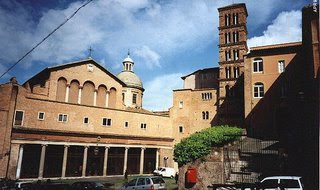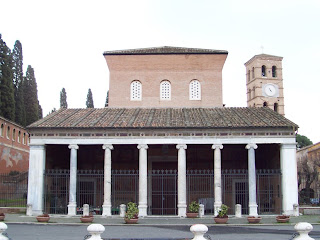Skip to comments.
Stational Churches (Virtually visit one each day and pray)
ACatholicLife.blogspot.com ^
| 2010
| Matthew
Posted on 02/16/2010 6:16:10 PM PST by Salvation
TOPICS: Catholic; Prayer
KEYWORDS: catholic; lent; pope; stationalchurches
Navigation: use the links below to view more comments.
first previous 1-20, 21-40, 41-60, 61-80 ... 121-128 next last
To: combat_boots; Mercat; Condor51; mlizzy; Bigg Red; VOA
San Clemente
|
Day XIII. Monday Week II "Lord, may this communion bring us pardon and lead us to the joy of heaven. We ask this in the name of Jesus the Lord. Amen" (Prayer after Communion for Today).
San Clemente. Clement was a slave owned by the cousin of the emperor, Domitian. He was succeeded by the martyr Linus (66-78), the martyr Cletus (79-91), and then Clement (91-101). He may have been a co-worker with Paul (Phil 4:3) and a witness of Peter and Paul's martyrdoms. He wrote a letter to the Corinthians (96), the first known example of a Pope intervening in the affairs of another Church and speaks of the Orders of bishop, priest, and deacon as being instituted by Christ (for a while this was considered by some to be part of the New Testament). Legend has it he was martyred by being drowned with an anchor tied around his neck. His earthly remains rest under the main altar. Saints Cyril and Methodious are also buried here.
This ancient church is living history. It was first a temple to Mithras (pre-Roman). An imperial palace was then built on top of the ruins (1st C). Clement had a house here where he gathered the faithful for Divine Liturgies. It continued to be a place of worship. |
 |
|
|
|
Constantine started to built a church on this site and it was dedicated in 384. This church was destroyed by the Norman invaders (1804). The present church was built on top of the ruins by Pachal II (1099-1118). The former ruins have been excavated so you can now go down and visit all four levels of history. Extraordinary!! Raphael was the architect (1483-1520). |
41
posted on
02/28/2010 7:47:46 PM PST
by
Salvation
("With God all things are possible." Matthew 19:26)
Comment #42 Removed by Moderator
To: All
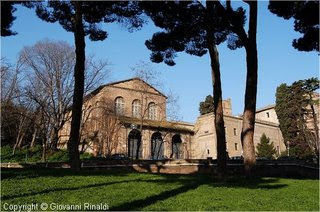
Today's Stational Church is the Church of St. Balbina.
Information is from the
Canon Regulars of St. John Cantius:
The Station today is at the sanctuary of St. Balbina—a Roman virgin, who lived in the second century and whose remains, along with those of her father, the martyr St. Quirinus, lies under the altar. This church stands on a slope of the Aventine Hill.
St. Balbina followed Christ. To Him she gave her home that it might henceforth be His home where He would "have mercy on His people according to His great mercy and blot out their iniquity" and where they would seek His face, and finding it, "relate all His wonders, and be glad and rejoice and sing praise to the name of the Most High." I seek Your face! Your face, O Lord, will I still seek. Turn not away Your face from me.
Let us pray: Of Thy goodness, we beseech Thee, O Lord. Continue to help us in the observance of this holy fast, that having learned our duties from Thee, we may accomplish them by the help of Thy grace. Through Christ, Our Lord.
Amen.
43
posted on
03/01/2010 11:38:49 PM PST
by
Salvation
("With God all things are possible." Matthew 19:26)
To: All
Santa Balbina
|

Day XIV. Tuesday, Week II. "Lord, help us always, for without you we are bound to fail" (Adapted from Collect for today).
Santa Balbina. Unfortunately, little known about Saint Balbina except from earliest times she was venerated as a Christian martyr, probably at the time of emperor Hadrian (132). Tradition has it that she was baptized and chose Christ as her spouse. Since she refused to be unchaste, she and her father, Quirinus, were accused, convicted, and executed for being Christian. Pope Saint Mark (336) erected this church in Balbina's memory and the earthly remains of father and daughter lie together under the altar. |
|
|
|

|
|
|
|
|
|
|
|
44
posted on
03/01/2010 11:41:46 PM PST
by
Salvation
("With God all things are possible." Matthew 19:26)
To: Salvation
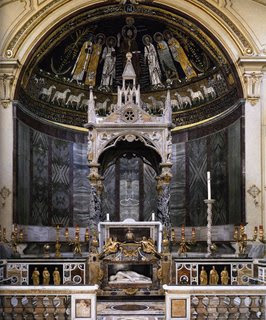 Today's Stational Church is the Church of St. Cecilia in Trastevere.
Today's Stational Church is the Church of St. Cecilia in Trastevere.
Information is from the Canon Regulars of St. John Cantius:
In the heart of Transtiber Rome, entered by way of a Baroque gateway portal and a cheerful courtyard, towers the splendid church of St. Cecilia, in which is buried St. Cecilia, the virgin-martyr. In the fifth century, this church was one of the most celebrated churches in Rome.
On Ash Wednesday, the church was St. Sabina, the martyr-matron. On Wednesday of the first week of Lent, we visited St. Mary Major. On this third Wednesday, it is again a woman—the virgin-martyr and "glory of the early Church," St. Cecilia, who leads us to "the Son of Man, who came not to be served but to serve, and to give His life as a ransom for many."
One reason why Christians often are lacking in joy and holy enthusiasm is their lack of purity. We know how the flesh lusts against the spirit and the spirit against the flesh. The two cannot live in the same house. One of the two must go. St. Cecilia knew no compromise. Her baptismal garment was never stained by impurity.
Let us pray: O God, the restorer and lover of innocence, turn towards Thee the hearts of Thy servants; that being inflamed with the fervor of Thy Spirit, they may be found both steadfast in faith and fruitful in good works. Through Christ, Our Lord. Amen.
45
posted on
03/03/2010 12:03:42 AM PST
by
Salvation
("With God all things are possible." Matthew 19:26)
To: combat_boots; Mercat; Condor51; mlizzy; Bigg Red; VOA
Santa Cecilia

Day XV. Wednesday, Week II
"The Son of Man will be handed over to the chief priests and scribes, who will condemn him to death. They will turn him over to the Gentiles, to be made sport of and flogged and crucified. But on the third day he will be raised up" (Gospel for today - Mt 20:18-19).
Santa Cecilia in Trastevere. Through prayers and good example, Saint Cecilia converted her husband, St. Valerian, and her brother-in-law, St. Tiburtius, to Christianity. As a result, all three were condemned to death (230). They tried unsuccessfully to suffocate St. Cecilia in her own bath by steaming her alive. Witnesses heard her singing songs to God throughout the ordeal (that is why she is the patron saint of music). They then tried to
behead her. By Roman law, the executioner only had three attempts to severe the head.

The executioner, unsuccessful, ran away leaving her to slowly bleed to death. During the next few days, many were converted by her preaching. She died in a pool of her own blood, her fingers outstretched to proclaim her faith in the Triune God.
The bodies of this holy family were transferred to this church in 821 by Pope Paschal I (817-824). (See the mosaic depicting Paschal (with square nibus) giving the church to St. Cecilia who introduces him to St. Paul. Jesus in the center and next to him is Ss. Peter, Valerian, and Agatha. Below are the 12 lambs approaching Christ the Lamb of God from Bethlehem and Jerusalem.) In 1599, her tomb was opened and her body was found to be incorruptible. The sculptor Moderno was there, drew what he saw, and later made the famed statue (see photo). It' is located below the main altar.
46
posted on
03/03/2010 12:09:30 AM PST
by
Salvation
("With God all things are possible." Matthew 19:26)
To: All
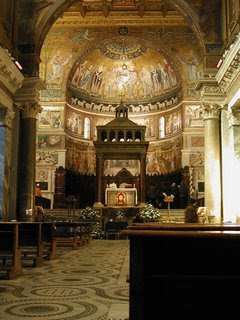
Today's Stational Church is the Church of St. Mary in Trastevere. Great photos of this stational church are available on the blog
Argent by the Tiber.
Information is from the
Canon Regulars of St. John Cantius:
In the heart of Transtiber, in a beautiful Romanesque square stands the church of St. Mary. On the spot of this church, shortly before the birth of Christ, oil gushed out of the ground. Mary carried Christ "the Anointed One" (reference to the oil) in her arms.
The Mother of God is today's stational leader to Christ, the Light of the world. We fly to your patronage, Holy Mother of God. Do present our humble prayers to Him, whom you did bring forth, the King that rules heaven and earth. Help us, good Mother, that He may keep us away from the broad road, which leads to darkness and perdition and take us on the narrow but sure way to eternal light and life.
It is Thursday, four weeks from the great Eucharistic Thursday. May today's Eucharistic action give us light to see the right way and strength to follow it. And Christ is the "Way," and Mary, our leader to this "Way"—Per Mariam ad Jesum!
Let us pray: Grant us, we beseech Thee, O Lord, the help of Thy grace, that being duly intent on fasts and prayers, we may be delivered from enemies of soul and body. Through Christ, Our Lord. Amen.
47
posted on
03/04/2010 12:34:43 AM PST
by
Salvation
("With God all things are possible." Matthew 19:26)
To: combat_boots; Mercat; Condor51; mlizzy; Bigg Red; VOA
Santa Maria in Trastevere

|
Day XVI. Thursday, Week II.
"God of love, bring us back to you. Send your Spirit to make us strong in faith and active in good works. Grant this through our Lord Jesus Christ, your Son, who lives with you and the Holy Spirit, one God, for ever and ever. Amen" (Collect for today).
Santa Maria in Trastevere. One of the oldest and most beautiful churches in the city, Santa Maria was built on the site of a miraculous font of oil, which flowed for one day in the year 36 BC. This was interpreted as a divine portent that an Anointed One would be born whose power would flow to the entire world. The Christians later understood this to be fulfilled in Christ. An oratory was built here by |
|
|

|
|
Pope Callistus I (217-222) and later rebuilt twice, the last as a offering of thanksgiving for the end of the schism in 1124 when the anti-pope resigned. (The mosaics in this church are extraordinary. The photo is one of Jesus' birth.) Thursday’s churches are places where the poor are tended to in a special way. Today, the Community of Sant’Egidio tend to the needs of the poor from this church. |
|
|
|
|
|
|
48
posted on
03/04/2010 12:38:25 AM PST
by
Salvation
("With God all things are possible." Matthew 19:26)
To: Salvation
I forgot these last night — so tonight you get two days worth. LOL!
49
posted on
03/05/2010 10:43:32 PM PST
by
Salvation
("With God all things are possible." Matthew 19:26)
To: All
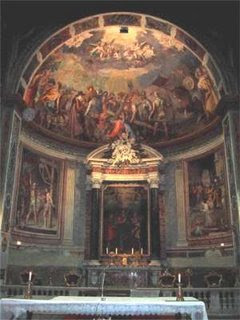
Today's Stational Church is the Church of St. Vitalis.
Information is from the
Canon Regulars of St. John Cantius:
Mother Church points today to the "Great Friday" on which our High Priest and Redeemer obtained for us eternal redemption. She takes us today to the church of St. Vitalis—father of the holy martyrs, Gervase and Protase. For his loyalty to Christ, St. Vitalis was first buried up to the waist in an old cistern and then stoned to death.
Here at the altar of this martyr — his name means "full of life" — Holy Mother Church directs our attention to the life-giving death of the Savior. In four weeks we will celebrate the life-begetting Passion of Christ. Pointing to this great mystery, the Church prays that we continue to prepare for it; that the holy fast may chasten us and make our hearts pure, so that when the vintage time of the Paschal solemnity arrives, the divine householder may not be obliged to say: "I looked that my vineyard should bring forth grapes, and it has brought forth thorns."
May St. Vitalis, who drank so abundantly of the sacred winepress of the Lord's Passions, accompany us today to the Eucharistic Banquet in which this most Holy Passion is rendered present and the fruits thereof applied to our souls. Here all of us will become "Vitales"—living members of Christ—the Fountain of all life and holiness.
Let us pray: Grant, we beseech Thee, Almighty God, that cleansed by this holy fast, we may be brought by Thee with pure hearts to the holy season, which is to come. Through Christ, Our Lord. Amen.
50
posted on
03/05/2010 10:48:42 PM PST
by
Salvation
("With God all things are possible." Matthew 19:26)
To: combat_boots; Mercat; Condor51; mlizzy; Bigg Red; VOA
San Vitale
| |
|
|
Day XVII. Friday, Week II. "Lord, may this communion so change our lives that we may seek more faithfully the salvation it promises. Grant this through Christ our Lord. Amen" (Prayer after Communion for today).
San Vitale. Tradition holds that Saint Vitale was a Christian soldier stationed near Milan during the time of emperor Marcus Aurelius (161-180). When he encouraged others who were being martyred, he was racked. (See woodcut from door.) Afterwards, according to the frescos in this ancient church, he was thrown into a pit and
buried alive. The basilica was consecrated by Pope St. Innocent I (401) and is really quite remarkable. Evidently, from the fresco in the apse and the woodcut from the door, it was also a place of great devotion towards Simon the Cyrenian, who was enlisted to carry the cross for Jesus. 
|
 |
51
posted on
03/05/2010 10:55:54 PM PST
by
Salvation
("With God all things are possible." Matthew 19:26)
To: All
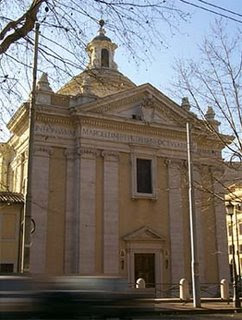
Today's Stational Church is the Basilica of Sts. Marcellinus & Peter.
Information is from the
Canon Regulars of St. John Cantius:
This Station is in the basilica founded by St. Helen on the Via Lavicana, in which were buried the bodies of St. Marcellinus, priest, and St. Peter, exorcist, martyred at Tome during the Diocletian persecution. Their names are mentioned in the Roman Canon of the Mass.
May today's stational saints, not brothers in the flesh, but in spirit, obtain for us the gift of gratitude both for our holy calling—God's free gift—as well as for the grace of conversion, our homecoming to the Father. For the remainder of our life may "the unspotted law of the Lord, which converts souls, and the testimonies of our faithful Lord fill us with such wisdom that we shall show forth the glory of God, and declare the works of His hands."
Let us pray: Grant, we beseech Thee, O Lord, a saving virtue to our fast; that the chastisement of the flesh, which we have taken upon us may bestow new life to our souls. Through Christ, Our Lord. Amen.
52
posted on
03/05/2010 10:59:02 PM PST
by
Salvation
("With God all things are possible." Matthew 19:26)
To: combat_boots; Mercat; Condor51; mlizzy; Bigg Red; VOA
Santi Marcellino e Pietro
Day XVIII. Saturday, Week II.
"My son, you should rejoice, because your brother was dead and has come back to life; he was lost and is found"
(Gospel for today – Lk 15:32).
Santi Marcellino e Pietro. Saint Marcellinus was a prominent priest and Saint Peter was an exorcist during the reign of emperor Diocletian (284-303). While they were imprisoned, they continued to evangelize. Tradition tells us that their jailor was a sceptic who said that if Jesus was truly Lord, he would set them free from the jail. That night, they were miraculously freed. The jailor and his family and some 300 others converted. Father Marcellino and Peter were then secretly arrested and beheaded. A church was later built to house their remains. The photo is of the crucifix, which is said to be miraculous.
53
posted on
03/05/2010 11:02:21 PM PST
by
Salvation
("With God all things are possible." Matthew 19:26)
To: Salvation
Today's Stational Church is the Basilica of St. Lawrence Outside the Walls.
The stational Mass brings us to another basilica, St. Lawrence Outside the Walls, erected by the Emperor Constantine in the year 330. As the basilica is near the Verano cemetery and above ancient catacombs, where the bodies of the martyred St. Lawrence, St. Stephen and St. Justin were laid to rest, the penitential character of the Lenten Station takes on particular significance.
On this day, the catechumens of old were taken to the tomb of St. Lawrence, the illustrious deacon whose "eyes were ever towards the Lord." Today, they had to decide whether they were "for Christ or against Him." If for Him, then "all fornication and uncleanness, covetousness, obscenity, foolish talking, gossip must be laid aside," "for no fornicator, or unclean or covetous person has inheritance in the kingdom of Christ Jesus."
We have made our decision years ago. On the day of our baptism, we renounced Satan, his pomps and his works. "Heretofore we were darkness," but by the waters of baptism "were made light in the Lord."
If we are not keeping our baptismal oath, then "the last state of that man becomes worse than the first, for the unclean spirit will return into the house from whence he came, together with seven other spirits more wicked than himself, and dwell there." The result will be a scattering, a breaking up of the supernatural life, a separation from Him who is our blessed hope in this life and our eternal joy in the next.
Let us pray: Pluck my feet out of the snare. Look upon me and have mercy on me for I am alone and poor. Through Christ, Our Lord. Amen.
54
posted on
03/07/2010 4:08:35 PM PST
by
Salvation
("With God all things are possible." Matthew 19:26)
To: All
San Lorenzo in Panisperna

Day XIX. Sunday, Week III.
"I will prove my holiness through you. I will gather you from the ends of the earth; I will pour clean water on you and wash away all of your sins. I will give you a new spirit within you, says the Lord (Entrance antiphon for today - Ez 36:23-26).
San Lorenzo Fuori le Mura. If you remember, the first week of Lent, we visited San Lorenzo in Panisperna, which was built over the traditional place where Saint Lawrence was burnt to death (258). This church was built over his tomb (see photo). Behind the tomb is a marble slab stained with blood on which was under the place where the
Romans roasted their victims alive.
Also in the tomb are the earthly remains of Blessed Pius IX (1846-1878), founder of the North American College (where I live). His body is incorrupt (see photo). This church was, miraculously, the only church in Rome destroyed during World War II, when it was hit by allied bombs (August 1943). Pius XII is remembered very fondly for his kindness to all the victims.
55
posted on
03/07/2010 4:13:30 PM PST
by
Salvation
("With God all things are possible." Matthew 19:26)
To: combat_boots; Mercat; Condor51; mlizzy; Bigg Red; VOA
56
posted on
03/07/2010 4:14:39 PM PST
by
Salvation
("With God all things are possible." Matthew 19:26)
To: All
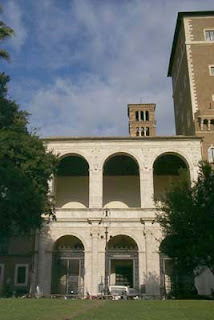
Today's Stational Church is the Basilica of St. Mark.
Information is from the
Canon Regulars of St. John Cantius:
In the historic center of the city, near Piazza Venezia, stands the elegant basilica of St. Mark. St. Mark had a very important role in the evangelization work in the Rome of his time, and after the death of the Apostles, it was in this city that he wrote the Gospel of Mark.
The more sincerely we enter into each Lenten day, the more perfectly will the Holy Eucharist transform us and the more pleasing to God will be our Lenten efforts. Our spiritual life will take on a freshness, like that of a child, or rather, it will glow in the very freshness of Christ Himself. The branch will receive daily a new portion of vital energy from the infinite freshness and vitality of the Vine.
Let us pray: Pour forth in Thy mercy, we beseech Thee, O Lord, Thy grace into our hearts, that as we abstain from carnal food, may we also restrain our senses from harmful excesses. Through Christ, Our Lord. Amen.
57
posted on
03/07/2010 10:30:12 PM PST
by
Salvation
("With God all things are possible." Matthew 19:26)
To: combat_boots; Mercat; Condor51; mlizzy; Bigg Red; VOA
San Marco

Lord I am not worthy to receive you, but only say the word and I shall be healed" (Ordinary of the Most Holy Mass - Mt 8:8).
San Marco. Built by Pope Saint Mark and dedicated to Saint Mark the Evangelist in 336, some say that this church was built on the site of the home where the evangelist Mark lived while here in Rome. It was once the "national" church of the kingdom of Venice and is noted for its apse mosaic (833-844). Inside the nave is a portion of a marble column, which was hollowed out and used as a head of a well (9-11 C). The 11th century inscription invites the thirsty to drink of the well but curses the one who should charge for the water drawn from it. It is now used as the baptistry. Under the altar (see photo) are the remains of Saints Abdon and Sennen who where martyred a few blocks away in the Colosseum. Also in the church is Pope Saint Mark, and relics of Saint Mark the Evangelist, some of the Holy Innocents, and even a vial, which was once alleged to contain some of the Darkness that Covered Egypt (I guess it is like the canned Florida sunshine!). The photo is of the altar with the enthroned Word!
58
posted on
03/07/2010 10:37:15 PM PST
by
Salvation
("With God all things are possible." Matthew 19:26)
To: All
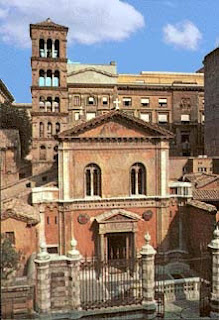
Today's Stational Church is the Church of St. Pudenziana.
Information is from the
Canon Regulars of St. John Cantius:
The church of St. Prudentiana, on the Viminal Hill, was one of the most venerated places for Roman Christians. St. Prudentiana lived here with her sister, St. Praxedes. Here, St. Peter received hospitality and the first Christians often assembled. Today, this church stands rather forgotten because it was closed for a very long time.
We turn to St. Prudentiana on this day. May she obtain for us by her powerful prayers:
1. The grace of mutual forgiveness, so that we may be able to say in truth: "Forgive us our trespasses, as we forgive those that trespass against us"—Not seven times, but seventy times seven.
2. The grace also of true love for our glorious Lord and for each other. Prudentiana shows us the way. Where charity and love reign, there is God. Christ will then be in our midst. And He shall be the Savior, Lord and King of our hearts and our home.
Let us pray: May the effect of our redemption be applied unto us, we beseech Thee, O Lord, by means of your grace, ever restraining us from human excesses and conducting us to the gift of salvation. Through Christ, Our Lord. Amen.
59
posted on
03/08/2010 10:11:59 PM PST
by
Salvation
("With God all things are possible." Matthew 19:26)
To: combat_boots; Mercat; Condor51; mlizzy; Bigg Red; VOA
Santa Pudenziana
(Photo is of the mosaic in the apse, which is one of the oldest Christian mosaics in Rome)


Day XXI. Tuesday, Week III.
"Lord, when my brother wrongs me, how often must I forgive him? Seventy times?" (Gospel for today - Mt 18:21).
Santa Pudenziana. This church was erected over the site of the house of the Senator Pudens (possibly of 2 Tim 4:21 fame), who hosted Saint Peter here in Rome. He converted along with his daughters, Pudenziana and Praxedes, and sons, Timothy and Novatus. During the persecutions of Nero, the sisters would bury the martyrs and collected their spilt blood, which they hid in a well in the house (one of the corporal works of mercy).
They were discovered and executed as well. Over the altar, bristling with reliquaries (see photo), is Saint Pudenziana being welcomed into heaven by her guest, Saint Peter. The other photo is of the mosaic in the apse, which is one of the oldest Christian mosaics in Rome. Dating from the close of the 4th C, it predates the Byzantine influence and depicts the heavenly Jerusalem with Christ as emperor surrounded by the apostles dressed as senators. (The two photos can be fitted, one on top of the other).
60
posted on
03/08/2010 10:19:11 PM PST
by
Salvation
("With God all things are possible." Matthew 19:26)
Navigation: use the links below to view more comments.
first previous 1-20, 21-40, 41-60, 61-80 ... 121-128 next last
Disclaimer:
Opinions posted on Free Republic are those of the individual
posters and do not necessarily represent the opinion of Free Republic or its
management. All materials posted herein are protected by copyright law and the
exemption for fair use of copyrighted works.
FreeRepublic.com is powered by software copyright 2000-2008 John Robinson
